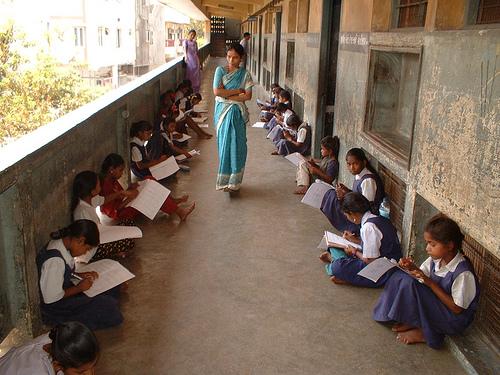Discrimination in Grading in India
- Teachers
- Discrimination
- Tracking
Researchers used a randomized evaluation to test for discrimination in grading in India. They recruited teachers to grade exams, and randomly assigned child “characteristics” (age, gender, and caste) to the cover sheets of exams to ensure that were was no relationship between these observed characteristics and the exam quality. They find that teachers gave exams that were assigned to be lower caste worse scores than those that were assigned to be high caste.
Policy issue
Numerous studies have researched the “Pygmalion effect,” which prescribes that students perform better or worse simply because teachers expect them to do so. Yet little is known about the channels through which teachers formulate or transmit such expectations. Of particular concern is whether or not teachers systematically treat students differently based on observable characteristics, such as minority status or gender. Such discrimination could have long-lasting consequences on the future of these children by reinforcing erroneous beliefs of inferiority and discouraging them from staying in school or pursuing further study. Discrimination in grading practices is one of the channels through which teachers can treat students unfairly and is of particular importance given the significance of entrance exams for gaining admission to universities in many countries. Additional evidence on the sources of discrimination in education could lead to more effective policies to address the issue.
Context of the evaluation
In India, the Hindu religion traditionally divided groups into hereditary castes that denoted both a family’s place within the social hierarchy and their professional occupation. In order of prestige, these castes were the Brahmin, Kshatriya, Vaishya, and Shudra respectively denoting priests, warriors/nobility, traders/farmers, and manual laborers. In principle, individuals are now free to choose occupations regardless of caste, but these historical distinctions have created social and economic inequities that still exist today. Given the large gap in family income and job opportunities between households from low and high-caste groups, children from traditionally disadvantaged castes tend to have worse educational outcomes than those from more advantaged groups. While it is difficult to identify the influence of caste separately from poverty and low socio-economic status, the potential for discrimination in schools is significant.

Details of the intervention
This experiment sought to investigate grade discrimination by local teachers. The researchers designed an exam competition in which children recruited from the community competed for a prize of INR 2500 (US$58), which was equivalent to 56 percent of parents’ average monthly income. In April 2007, 69 children between the ages of 7-14 years old completed exams that tested their math, language, and artistic skills. Afterwards, researchers removed any information that would reveal the test-taker’s identity and randomly assigned a different set of child “characteristics” (age, gender, and caste) to each exam’s cover sheet. Since the characteristics of the child were randomly assigned, there should be no relationship between the assigned characteristics and test scores. Any correlation between the characteristics and exam scores would be evidence of discrimination.
A total of 120 teachers were recruited from local schools and were paid to grade the exams. Teachers were given 25 exams to grade and were informed that a substantial prize would be awarded to the students with the top scores in each age group. Teachers were given an answer sheet to use for grading but were permitted to offer partial credit at their discretion. In all, each exam was graded by an average of 43 teachers. To ensure that teachers viewed the cover sheets, they were asked to copy the child’s characteristics from the cover sheet onto the grade roster.
Researchers collected information on students’ caste, gender, and age. They also collected information on teachers’ religion, caste, educational background, age, and gender in order to determine if teachers are more likely to show a positive bias toward students of their own gender or caste.
Results and policy lessons
Magnitude of Discrimination: There was evidence of discrimination against low-caste exams, but the magnitude of the effect was small. Teachers scored exams that were assigned low-caste characteristics 0.03-0.09 standard deviations lower than exams that were assigned high caste characteristics. The researchers estimate that 20 percent of the performance gap between high- and low-caste students could be attributed to discrimination and that most children’s rankings in the contest would not have changed in the absence of discrimination. There was no evidence of discrimination by gender or age.
Nature of Discrimination: The order in which exams were graded determined if they were discriminated against. Teachers were more likely to discriminate against low-caste students on the first exams they graded than on the last exams they graded. The scores of low-caste exams that were graded first were on average 0.22 standard deviations lower than the scores of high- caste exams graded first. There was little evidence of discrimination on the last exams graded, with a difference of only 0.04 standard deviations between low- and high-caste exams. Teachers may have discriminated more in the first few exams than the last because they were unsure how to give out partial credit and what the final grade distribution should look like. Thus they may have given more partial credit to high-caste students because they thought high-caste students would end up higher in the grade distribution.
The subjectivity of the academic subject did not have an effect on grade discrimination. Teachers discriminated against low-caste exams as much on math sections as they did on art and language sections. They achieved this by being more generous with partial credit on high-caste exams in the math and language sections.
There was no evidence that teachers gave higher grades on exams that were assigned characteristics similar to their own. To the contrary, low-caste teachers discriminated against low-caste exams, while high-caste teachers did not appear to discriminate at all.
Hanna, Rema, and Leigh Linden. 2012. "Discrimination in Grading." American Economic Journal: Economic Policy 4(4): 146-68